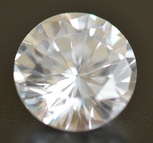Simulated diamonds or “fake” diamonds may be shiny and bright, but they are nothing like the real thing. A simulated diamond is something that looks similar to a diamond but does not have the same properties (weight, specific gravity, refractive index, hardness, etc.).
Nature’s diamonds are made of only one element–carbon. Billions of years ago, suffocating heat and extreme pressure deep with in Earth forced atoms of carbon into diamond crystals. The resulting gemstone is the hardest natural material ever discovered.
The only guaranteed way to be certain that a diamond is real is to take it to an expert who is trained and certified in the science of gemology. A gemologist can look at the stone under magnification and perform tests to know for sure. The easiest way to ensure you are purchasing a real, natural diamond is to buy one that has a certification from the AGS, GIA or EGL grading laboratories.
Simulated diamonds are made of glass, minerals or synthetic and in recent years there has been an increase in the number of simulated diamonds marketed under a variety of different names.
Cubic Zirconia
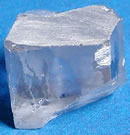 Cubic Zirconia is a cubic form of zirconium oxide that is created in a laboratory, thus it is not a mineral. Because of its low cost, durability, and close visual likeness to diamond, synthetic cubic zirconia has remained an important diamond simulant since 1976. Cubic zirconia cannot be cut quite as sharply as a diamond can and tends to chip or turn yellowish over time.
Cubic Zirconia is a cubic form of zirconium oxide that is created in a laboratory, thus it is not a mineral. Because of its low cost, durability, and close visual likeness to diamond, synthetic cubic zirconia has remained an important diamond simulant since 1976. Cubic zirconia cannot be cut quite as sharply as a diamond can and tends to chip or turn yellowish over time.
Brand names include Russian Brilliants, Diamond Nexus, Asha, Diamonique, CARAT*, Van Graff, Diamonelle, Asha, Zirconite, etc.
Click here for our detailed discussion of Cubic Zironia
Moissanite
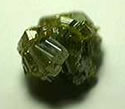 Silicon carbide is a mineral used to make simulated diamonds but is rare in nature and was originally discovered in meteorite fragments. For over a hundred years the stone was little more than a footnote in research books. Then, in 1995, Cree Inc. a US based company that manufactures silicon carbide devices developed a synthetic Moissanite from silicon carbide crystals. Moissanite costs about one-tenth of its diamond counterpart.
Silicon carbide is a mineral used to make simulated diamonds but is rare in nature and was originally discovered in meteorite fragments. For over a hundred years the stone was little more than a footnote in research books. Then, in 1995, Cree Inc. a US based company that manufactures silicon carbide devices developed a synthetic Moissanite from silicon carbide crystals. Moissanite costs about one-tenth of its diamond counterpart.
Click here for our detailed discussion of Moissanite
White Sapphire
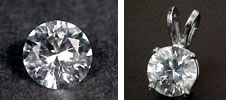 White Sapphire, along with its sister the Ruby, is of the mineral corundum. While colored sapphires owe their colors to varying chemical combinations, white sapphires are pure corundum and therefore colorless. With a hardness of 9 (corundum is the hardest mineral known next to diamond), white sapphires are very durable, making them an excellent choice for any jewelry piece.
White Sapphire, along with its sister the Ruby, is of the mineral corundum. While colored sapphires owe their colors to varying chemical combinations, white sapphires are pure corundum and therefore colorless. With a hardness of 9 (corundum is the hardest mineral known next to diamond), white sapphires are very durable, making them an excellent choice for any jewelry piece.
In the 1980s the technique for infusing blue (and more recently red) color into the surface of the sapphire was perfected. This process is known as diffusion treatment. The chemicals that cause the blue color in the sapphire (iron oxide and titanium oxide), are induced into the surface layer of the sapphire by heating the stone almost to its melting point (about 1800 C).
 Natural white sapphire has become very scarce in the marketplace since companies that color treat sapphire have consistently outbid gem dealers for the larger sapphire rough. Synthetic white sapphire is available in greater supply.
Natural white sapphire has become very scarce in the marketplace since companies that color treat sapphire have consistently outbid gem dealers for the larger sapphire rough. Synthetic white sapphire is available in greater supply.
The sapphire, September’s birthstone, is one of the oldest known stones in written history. The ancients credited the sapphire to be endowed with the power to influence spirits, to be a charm against unfaithfulness and capable of making peace between foes.
YAG
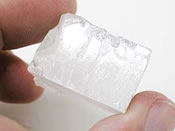 Yttrium has been used for decades in a diamond simulant called YAG or yttrium aluminum garnet which has physical properties similar to natural garnets but with a brilliance and fire more similar to diamond.
Yttrium has been used for decades in a diamond simulant called YAG or yttrium aluminum garnet which has physical properties similar to natural garnets but with a brilliance and fire more similar to diamond.
Yttrium aluminum garnet (YAG) is a man-made material used in lasers that duplicates the atomic structure of garnet. Colorless YAG is used as a simulant for diamond but is not use much anymore as it has mostly been replaced by Cubic Zirconia as a simulated diamond.
GGG (Gadolinium Gallium Garnet)
Gadolinium Gallium Garnet (GGG) was used in the past as a simulated diamond by has been largely replaced by cubic zirconia. It can be detected as different from diamond by heat conductivity, density, and hardness tests. Gadolinium Gallium Garnet (GGG, Gd3Ga5O12) is a synthetic crystalline material of the garnet group, with good mechanical, thermal, and optical properties. It is typically colorless.
Strontium Titanate
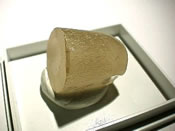 Strontium titanate is a simulated diamond with great fire but is relatively soft with a 5 on Mohs Scale. With its lack of double refraction (like diamond), it is easily separate it from the harder moissanite. The dispersion of CZ is significantly higher than diamond producing color and fire that no diamond can produce but strontium titanate is probably the kind of fire with ten times the dispersion of diamond.
Strontium titanate is a simulated diamond with great fire but is relatively soft with a 5 on Mohs Scale. With its lack of double refraction (like diamond), it is easily separate it from the harder moissanite. The dispersion of CZ is significantly higher than diamond producing color and fire that no diamond can produce but strontium titanate is probably the kind of fire with ten times the dispersion of diamond.
It is a light show on the finger but usually is found only with a tint of yellow. The cost of rough strontium titanate is quite a bit more expensive than CZ but orders of magnitude less than diamond.
Rhinestones
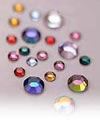 Rhinestones are artificial clear or colored stones of high luster made of glass, paste or gem quartz that are intended to simulate diamonds. The best rhinestones are cut from quartz crystal. Natural crystals from the bottom of the river Rhine in Germany were early substitutes for diamonds; hence the term Rhinestone. Some people also refer to them as crystals or stones. Generally, the stone’s cut combined with the overall quality determine the price. The higher the grade, the more the rhinestone will sparkle.
Rhinestones are artificial clear or colored stones of high luster made of glass, paste or gem quartz that are intended to simulate diamonds. The best rhinestones are cut from quartz crystal. Natural crystals from the bottom of the river Rhine in Germany were early substitutes for diamonds; hence the term Rhinestone. Some people also refer to them as crystals or stones. Generally, the stone’s cut combined with the overall quality determine the price. The higher the grade, the more the rhinestone will sparkle.
Very often you’ll see some rhinestones shining different colors. They are called Aurora Borealis (abbreviated AB) rhinestones. Aurora Borealis rhinestones are rhinestones that have a special coating (developed in 1955) which produces a rainbow of colors. It is applied to the surface of a glass stone or bead to create a rainbow-colored sparkle. The term Aurora Borealis is derived from the brilliant colors of yellow, orange, green and blue of the Aurora Borealis, the Northern Lights atmospheric phenomena.

